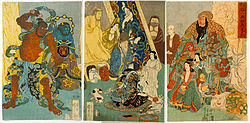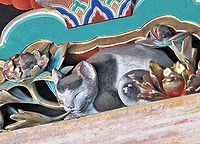
Hidari Jingoro
Encyclopedia

was a possibly fictitious Japanese artist, sculptor and carpenter. Although various studies suggest he was active in the early Edo period (around 1596-1644), there are controversies about the historical existence of the person. Jingorō is believed to have created many famous deity sculptures located throughout Japan, and many legends have been told about him. His famous nemuri-neko
Nemuri-neko
is a famous wood carving by Hidari Jingorō located in the East corridor at Tōshō-gū Shrine in Nikkō, Japan.「日光東照宮」 translation Nikkō Tōshō-gū Shrine「眠猫」 translation Nemuri-neko「左甚五郎の作」 translation Hidari Jingorō...
("sleeping cat") carving is located above the Kuguri-mon Gate amidst the sacred mountain shrines and temples of Nikkō, Japan. Amongst these shrines and temples is Nikkō Tōshō-gū
Nikko Tosho-gu
is a Shinto shrine located in Nikkō, Tochigi Prefecture, Japan. It is part of the "Shrines and Temples of Nikkō", a UNESCO World Heritage Site.Tōshō-gū is dedicated to Tokugawa Ieyasu, the founder of the Tokugawa shogunate. Initially built in 1617, during the Edo period, while Ieyasu's son Hidetada...
, a shrine that honors the Shogun Tokugawa Ieyasu
Tokugawa Ieyasu
was the founder and first shogun of the Tokugawa shogunate of Japan , which ruled from the Battle of Sekigahara in 1600 until the Meiji Restoration in 1868. Ieyasu seized power in 1600, received appointment as shogun in 1603, abdicated from office in 1605, but...
.
Jingorō was a famous Edo period artist, designer, sculpturer, carpenter, and architect. After someone cut his right hand, he learnt to work with his left hand and became Hidari Jingorou (Hidari (左) means "left") (source: minna no nihongo shokyuu, lesson 37).
Stories about Jingorō are spread in wide regions in Japan. According to one, he once saw a woman of such exceptional beauty that he made a sculpture of her. Jingorō begins to drink in the company of the sculpture, and it begins to move, following Jingorō's lead. At first it had no emotion and could only imitate Jingorō's movements. However, when he places a mirror in front of the sculpture, the woman's spirit enters and it comes to life.


